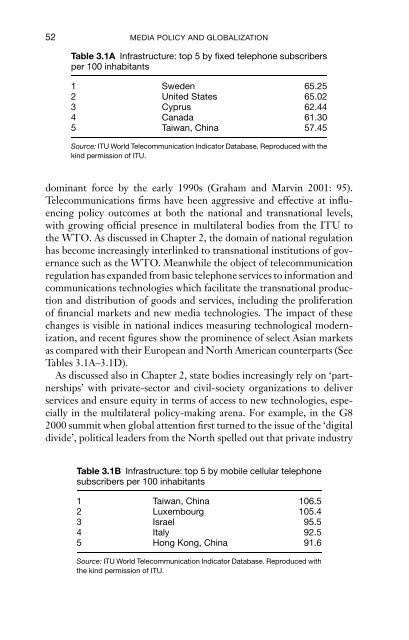Media Policy and Globalization - Blogs Unpad
Media Policy and Globalization - Blogs Unpad
Media Policy and Globalization - Blogs Unpad
You also want an ePaper? Increase the reach of your titles
YUMPU automatically turns print PDFs into web optimized ePapers that Google loves.
52 MEDIA POLICY AND GLOBALIZATION<br />
Table 3.1A Infrastructure: top 5 by fixed telephone subscribers<br />
per 100 inhabitants<br />
1 Sweden 65.25<br />
2 United States 65.02<br />
3 Cyprus 62.44<br />
4 Canada 61.30<br />
5 Taiwan, China 57.45<br />
Source: ITU World Telecommunication Indicator Database. Reproduced with the<br />
kind permission of ITU.<br />
dominant force by the early 1990s (Graham <strong>and</strong> Marvin 2001: 95).<br />
Telecommunications firms have been aggressive <strong>and</strong> effective at influencing<br />
policy outcomes at both the national <strong>and</strong> transnational levels,<br />
with growing official presence in multilateral bodies from the ITU to<br />
the WTO. As discussed in Chapter 2, the domain of national regulation<br />
has become increasingly interlinked to transnational institutions of governance<br />
such as the WTO. Meanwhile the object of telecommunication<br />
regulation has exp<strong>and</strong>ed from basic telephone services to information <strong>and</strong><br />
communications technologies which facilitate the transnational production<br />
<strong>and</strong> distribution of goods <strong>and</strong> services, including the proliferation<br />
of financial markets <strong>and</strong> new media technologies. The impact of these<br />
changes is visible in national indices measuring technological modernization,<br />
<strong>and</strong> recent figures show the prominence of select Asian markets<br />
as compared with their European <strong>and</strong> North American counterparts (See<br />
Tables 3.1A–3.1D).<br />
As discussed also in Chapter 2, state bodies increasingly rely on ‘partnerships’<br />
with private-sector <strong>and</strong> civil-society organizations to deliver<br />
services <strong>and</strong> ensure equity in terms of access to new technologies, especially<br />
in the multilateral policy-making arena. For example, in the G8<br />
2000 summit when global attention first turned to the issue of the ‘digital<br />
divide’, political leaders from the North spelled out that private industry<br />
Table 3.1B Infrastructure: top 5 by mobile cellular telephone<br />
subscribers per 100 inhabitants<br />
1 Taiwan, China 106.5<br />
2 Luxembourg 105.4<br />
3 Israel 95.5<br />
4 Italy 92.5<br />
5 Hong Kong, China 91.6<br />
Source: ITU World Telecommunication Indicator Database. Reproduced with<br />
the kind permission of ITU.


















